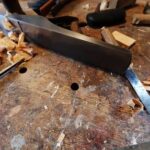Maintaining clean woodwork in your home is crucial in preserving the beauty and overall aesthetic of your living space. Properly cleaning and caring for the various types of woodwork, such as baseboards, door frames, and window sills, can make a significant difference in the appearance of your home. This article will provide you with essential tips and techniques on how to effectively clean woodwork in your home, ensuring that it remains in top condition for years to come.
Woodwork comes in different forms and finishes, each requiring specific cleaning methods to maintain their appearance and durability. Whether it’s finished or unfinished wood, knowing the proper cleaning techniques can help prevent damage while keeping the wood looking its best. Additionally, understanding the different types of woodwork in your home will allow you to gather the necessary cleaning supplies, such as wood cleaner, microfiber cloths, and a vacuum with a brush attachment.
By regularly maintaining clean woodwork in your home, you can elevate the overall look of your living space. From dusting and removing buildup to dealing with tough stains or scuff marks, this article will equip you with valuable insights on achieving beautifully clean woodwork throughout your home. So let’s dive into the world of woodwork cleaning and discover how you can keep your living space looking fresh and well-kept.
Understanding the Different Types of Woodwork in Your Home
Woodwork is a crucial aspect of any home’s interior, adding warmth and elegance to the overall aesthetic. Understanding the different types of woodwork in your home is essential when it comes to maintaining a clean and polished living space. Common woodwork includes baseboards, door frames, window sills, and crown molding, each requiring specific cleaning techniques to ensure their longevity and beauty.
- Baseboards: These are located at the bottom of walls, serving as a transition between the wall and the floor. They are prone to collecting dust, dirt, and pet hair. Regularly dusting or vacuuming baseboards can prevent buildup and keep them looking pristine.
- Door Frames: Door frames are often overlooked when it comes to cleaning. However, they are frequently touched and can easily accumulate fingerprints and grime. Using a gentle wood cleaner with a microfiber cloth can effectively remove any marks without causing damage to the wood.
- Window Sills: Window sills are constantly exposed to natural elements like sunlight, rain, and wind. Over time, they can become discolored or gather dirt. Wiping them down with a mild wood cleaner on a regular basis will prevent any buildup and maintain their natural luster.
In order to keep these different types of woodwork in top condition for years to come, implementing proper cleaning techniques is vital. Knowing how to clean woodwork in your home can not only improve its appearance but also prolong its lifespan. By following the right methods for each type of woodwork, you can ensure that they remain beautiful and well-maintained for years to come.
Gathering the Necessary Cleaning Supplies
Woodwork in your home adds beauty and character to your living space, but it also requires regular cleaning and maintenance to keep it looking its best. Gathering the necessary cleaning supplies is an essential first step in ensuring that your woodwork stays in great condition for years to come. When it comes to cleaning woodwork, using the right tools and products can make all the difference.
One of the most important items you’ll need is a suitable wood cleaner. There are different types of wood cleaners available on the market, including spray cleaners, oil-based cleaners, and water-based cleaners. Be sure to choose a product that is safe for use on the specific type of woodwork you have in your home. Additionally, microfiber cloths are essential for gently wiping down and polishing the wood surfaces without scratching them.
In addition to a wood cleaner and microfiber cloths, having a vacuum with a brush attachment can be incredibly helpful when it comes to cleaning baseboards, crown molding, window sills, and other hard-to-reach areas. The brush attachment can help remove dust and debris from intricate carvings or detailed work on your woodwork. By gathering these essential cleaning supplies, you will be well-prepared to begin the process of cleaning the woodwork in your home effectively.
| Cleaning Supplies | Description |
|---|---|
| Wood Cleaner | The appropriate type of wood cleaner for your specific woodwork |
| Microfiber Cloths | Gentle cloths for wiping down and polishing wood surfaces |
| Vacuum with Brush Attachment | To remove dust and debris from hard-to-reach areas of woodwork |
Preparing the Woodwork for Cleaning
When it comes to cleaning woodwork in your home, one of the first steps is to prepare the surfaces for a thorough cleaning. This involves dusting, removing any buildup or grime, and ensuring that the woodwork is in the best condition possible before you begin the actual cleaning process.
Dusting the Woodwork
Before diving into a deep clean, it’s important to start by dusting the woodwork in your home. Use a microfiber cloth or a duster to gently remove any loose dust, dirt, or cobwebs from the surface of baseboards, door frames, window sills, and any other wooden features in your home. This will prevent dirt from being spread around during the cleaning process and ensure that you start with a clean surface.
Removing Buildup or Grime
After dusting, take a closer look at the woodwork to identify any areas where there may be buildup or grime. Common areas for buildup include around doorknobs, near the floor where dust and dirt accumulate, and on window sills where moisture can lead to grime buildup.
Use a wood cleaner and a microfiber cloth to gently remove any buildup or grime from these areas. Be careful not to use too much moisture on unfinished wood as this can cause damage over time.
By taking the time to properly prepare the woodwork for cleaning through dusting and removing any buildup or grime, you’ll be setting yourself up for success when it comes to achieving beautifully clean woodwork in your home.
Proper Cleaning Techniques for Different Types of Woodwork
When it comes to cleaning the woodwork in your home, it’s important to understand the proper techniques for different types of wood. Whether you are dealing with finished wood such as baseboards and door frames, or unfinished wood like window sills, each requires specific care to ensure they remain clean and well-maintained.
Gentle Wiping for Finished Wood
For finished woodwork, such as baseboards and door frames, it’s crucial to use gentle wiping motions when cleaning. Start by dusting the woodwork with a microfiber cloth or using a vacuum with a brush attachment to remove any loose dirt or debris.
Then, using a wood cleaner specifically designed for finished wood surfaces, lightly dampen the microfiber cloth and wipe down the woodwork in the direction of the grain. Avoid using excessive moisture as this can lead to damage or warping of the wood.
Avoiding Moisture on Unfinished Wood
Unfinished woodwork, such as window sills, requires special care when cleaning to avoid damage. Since unfinished wood is more porous and vulnerable to moisture, it’s best to dry-dust using a microfiber cloth or vacuum with a brush attachment. If any stubborn dirt or grime remains, use minimal moisture on the cloth and gently wipe the affected areas. Be sure to dry the unfinished wood thoroughly after cleaning to prevent any water damage.
Tips for Tough Stains
In cases where there are tough stains or scuff marks on your woodwork, there are several methods you can try. For finished wood, consider using a mild solution of dish soap and warm water on a microfiber cloth and gently rubbing the affected area. For unfinished wood, a baking soda paste can help lift stains without damaging the material. Always test any cleaning solution on a small hidden area before applying it to the entire surface.
By understanding these proper cleaning techniques for different types of woodwork in your home, you can ensure that your living space remains clean and visually appealing while preserving the integrity of your wooden surfaces.
Dealing With Tough Stains or Scuff Marks on Woodwork
When it comes to maintaining clean woodwork in your home, one of the common challenges you may encounter is dealing with tough stains or scuff marks. Whether it’s on your baseboards, door frames, or window sills, these unsightly marks can detract from the overall appearance of your home. Fortunately, there are several effective ways to tackle these stubborn stains and restore the beauty of your woodwork.
Here are some tips for effectively dealing with tough stains or scuff marks on woodwork:
- Identify the type of stain: Before attempting to clean the stain, it’s important to determine what type of stain it is. Different stains may require different cleaning solutions and techniques.
- Use a gentle cleaner: For finished woodwork, a mild wood cleaner and a soft microfiber cloth can often do the trick. Avoid using harsh chemicals or abrasive materials that could damage the wood.
- Try natural remedies: For stubborn stains, you can try using natural remedies such as a paste made from baking soda and water, or a mixture of vinegar and water. Test these solutions in an inconspicuous area first to ensure they don’t discolor or damage the wood.
By following these techniques, you can effectively remove tough stains and scuff marks from your woodwork, restoring its original beauty and enhancing the overall look of your home.
Remember that regular maintenance is key to keeping your woodwork looking its best. By addressing any stains or scuff marks promptly and implementing a regular cleaning routine, you can ensure that your woodwork retains its pristine appearance for years to come.
Tips for Maintaining Clean Woodwork in Your Home on a Regular Basis
Maintaining clean woodwork in your home is essential not only for aesthetic reasons but also for the preservation of the wood itself. Over time, dust, dirt, and grime can build up on baseboards, door frames, window sills, and other woodwork, leading to a dull and unattractive appearance.
Regular cleaning not only keeps your home looking its best but also prevents damage to the wood from accumulating debris. In this section, we will discuss some tips for maintaining clean woodwork in your home on a regular basis.
One of the most important steps in keeping your woodwork clean is to regularly dust it with a microfiber cloth or use a vacuum with a brush attachment to remove any loose dirt or debris. This simple step can prevent buildup and significantly prolong the life of your woodwork. It is recommended to do this at least once a week to ensure that dust does not accumulate.
In addition to regular dusting, it is important to periodically deep clean your woodwork using a wood cleaner specifically designed for the type of finish on the wood. For finished woodwork, use a gentle cleaner and avoid excessive moisture. Unfinished or raw wood requires extra care when cleaning to avoid damaging the natural surface. By following these tips and being consistent with your cleaning routine, you can ensure that your woodwork remains in top condition for years to come.
| Wood Cleaning Tip | Recommended Frequency |
|---|---|
| Dust using microfiber cloth or vacuum with brush attachment | At least once a week |
| Deep clean with appropriate wood cleaner | Every few months as needed |
Final Thoughts
In conclusion, maintaining clean woodwork in your home is not only important for the appearance of your living space but also for the overall health and maintenance of your home. By regularly cleaning and maintaining your baseboards, door frames, window sills, and other woodwork, you can prevent the accumulation of dust, allergens, and grime that can affect indoor air quality.
Additionally, properly cared-for woodwork can enhance the aesthetic appeal of your home and contribute to a welcoming environment for both family members and guests.
Understanding the different types of woodwork in your home is essential to ensure that you use the proper cleaning techniques and products. Whether it’s finished or unfinished wood, each requires specific care to maintain its appearance and integrity. Gathering the necessary cleaning supplies such as wood cleaner, microfiber cloths, vacuum with brush attachment will equip you to tackle any dirt or stains that may have accumulated on your woodwork over time.
By following the proper cleaning techniques outlined in this article, you can ensure that your woodwork remains beautiful and well-maintained. From gentle wiping for finished wood to avoiding moisture on unfinished wood, understanding these methods will help you keep your home looking its best.
Taking care of tough stains or scuff marks promptly can prevent permanent damage and preserve the natural beauty of your woodwork. With regular maintenance using these tips for cleaning your woodwork at home, you can enjoy a clean and inviting living space for years to come.
Frequently Asked Questions
What Is the Best Cleaner for Wood Trim?
The best cleaner for wood trim is a mild soap and water solution. Mix a small amount of mild dish soap with warm water, dampen a soft cloth with the solution, and gently wipe down the wood trim. Avoid using harsh chemicals or abrasive cleaners that can damage the wood.
How Do You Clean Built Up Dust Off Wood?
To clean built-up dust off wood, you can use a microfiber cloth or duster to gently remove the dust particles. It’s important to avoid using too much pressure or harsh materials that could scratch or damage the wood surface. For hard-to-reach areas, consider using a vacuum cleaner with a brush attachment.
Can You Use Vinegar and Water to Clean Woodwork?
Yes, you can use vinegar and water to clean woodwork. Mix equal parts of white vinegar and water in a spray bottle, then lightly mist the solution onto a soft cloth or sponge and wipe down the woodwork.
Vinegar is an effective natural cleaner that can help remove dirt and grime without damaging the wood surface. Just be sure to test it on a small, inconspicuous area first to ensure compatibility with your specific type of woodwork.

Hi everyone! I’m a woodworker and blogger, and this is my woodworking blog. In my blog, I share tips and tricks for woodworkers of all skill levels, as well as project ideas that you can try yourself.





